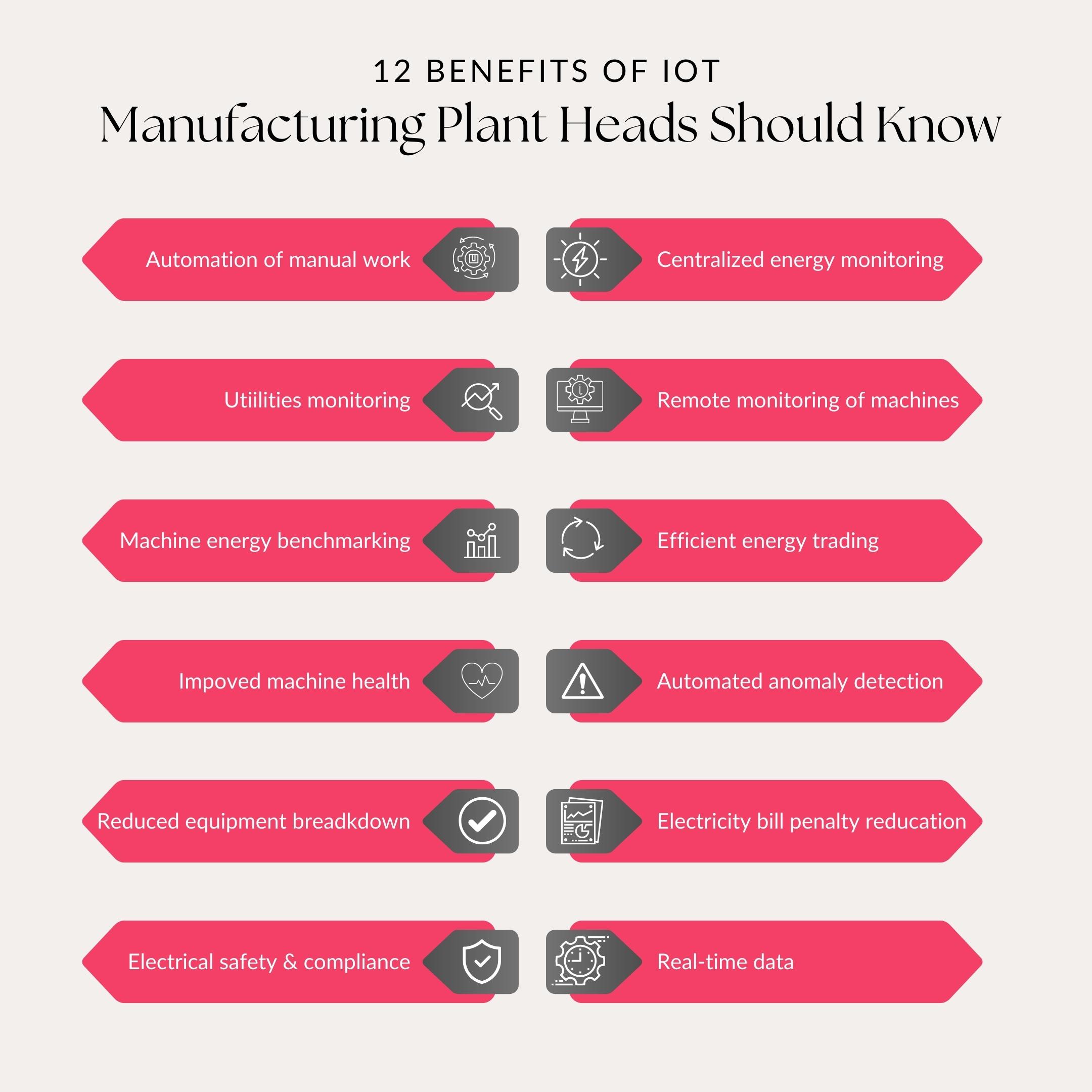Keep up with the latest IoT-based building automation, and follow us on LinkedIn!
IoT will be a game-changer for manufacturing companies. It is becoming increasingly popular due to the increased connected devices making our lives easier. The IoT can be used to make a manufacturing plant more efficient by taking over some manual operational work and saving money on electricity bills. Energy monitoring is a crucial step in any manufacturing process but can also be very time-consuming to do it manually. Fortunately, with the help of low-cost IoT technology, energy consumption data can be collected from machinery and power outlets across the entire factory on a continual basis.
In this article, we will discuss 12 cutting-edge benefits of IoT for manufacturing plants:
Benefits of IoT powered Automation in Manufacturing Plants
1) Automation of manual operational work
IoT systems can automate the manual work to take readings manually and analyze them using age-old excel based techniques. It can help reduce manual operation, improve data accuracy, and reduce cost by eliminating human intervention.
2) Centralized energy monitoring
The traditional approach to energy monitoring is manually noting down energy consumption in a notebook or excel file. But this approach has several limitations. It doesn’t give a holistic view of energy consumption across all the machines in a manufacturing plant, and it is impossible to understand the consumption pattern at different locations in the factory.
The IoT-based solution can centrally monitor energy consumption across machines of all manufacturing plants. It will provide a centralized dashboard to create visibility for the plant head and maintenance team to identify patterns and schedule machine maintenance as required.
The solution is designed to optimize energy consumption by providing real-time data on electricity, water and gas usage in the entire plant. The solution also provides insights into how much power each machine consumes and how much it costs per unit of production. By providing this information, the organization can take steps to reduce its carbon footprint, increase productivity and grow sustainably.
3) Utilities monitoring
Monitoring of utilities is quite common nowadays. The rise of the Internet of Things (IoT) has made it easier to monitor utilities. IoT system can automatically take the reading of various utilities water, energy & gas through the water meter, energy meter, and gas meter, along with the energy consumption of multiple machines. It will send the data to a centralized gateway, which is further sent to a cloud-based platform to create charts and analyze the same.
The major advantage of such systems is that they eliminate human errors, which are inevitable in manual monitoring systems. The systems are also cost-effective as they help reduce wastage of resources by notifying the owner of any anomaly in usage or consumption levels.
4) Remote monitoring of machines
IoT technology enables remote monitoring of machines and equipment, which helps in reducing the cost of maintenance by avoiding unnecessary visits on-site by maintenance engineers. It also allows real-time alerts on any issue which can be resolved before causing any major damage or breakdowns thereby increasing uptime for machines/equipment with lower downtime during peak hours for production.
5) Machine energy benchmarking
It will also help improve productivity by identifying which machines are consuming more electricity than others, thus providing better control over their usage during peak production time. Read more about machine energy benchmarking.
6) Efficient energy trading
Trading energy allows manufacturers to use less expensive electricity when available and avoid spikes in electricity costs from other states. Energy trading can be used to take advantage of price differences between states. IoT systems help you do efficient energy trading.
7) Improved machine health
It is essential to know the health of your machines to prevent them from breaking down and shutting down production. This is where IoT plays a vital role.
IoT systems can help you improve your machine health by identifying maintenance and anomaly in the machines. It can read voltage and current unbalance, among other electrical parameters, and help you fix it before it breaks down and shuts down your production unit. A well-maintained machine will last longer than its counterparts with poor maintenance records.
The ability of IoT to detect problems early on is what makes it such an attractive solution for many manufacturers around the world. It helps save money by ensuring that there are no unexpected breakdowns during operations and reducing downtime due to repairs or maintenance work being required on the equipment itself.
8) Automated anomaly detection
The IoT system allows for FDD i.e. fault detection and diagnosis which uses machine learning algorithms to detect anomalies in the data. The system creates a model based on historical data, which is then used against new incoming data. Suppose there is any deviation from the model. In that case, the IoT system will raise a ticket automatically so that the maintenance engineer can fix it before it becomes a bigger problem for the business.
9) Reduced equipment breakdown
IoT systems are capable of monitoring and collecting data from the machines, which can be used to prevent equipment breakdowns and reduce downtime.
Various IoT-based meters (Energy meters, water meters, gas meters) can be placed on multiple machines to monitor them. When any anomaly is detected, it can alert the engineer to take necessary action before a breakdown occurs. This helps avoid any unexpected downtime and loss in productivity during peak hours.
The collected data can also be used for predictive maintenance (PdM), which helps manufacturers plan maintenance activities more effectively by analyzing historical data from past events. PdM algorithms use this contextual information to predict when equipment will break down, allowing manufacturers to schedule preventive maintenance activities before they occur and avoid unplanned downtime.
10) Electricity bill penalty reduction
Power factor is a measure of how well a load draws current from the source. In other words, it measures how efficiently a load uses electricity. If a load has a poor power factor, then more current must be drawn from the source than would be required for an ideal load at the same current draw; this results in higher costs for both the consumer and utility company.
Power factor plays an important role while penalizing manufacturing companies to maintain it close to 1. Most manufacturers don’t have any visibility into the power factor of their plants. IoT-based systems provide visibility into power factor and help avoid any electrical penalty.
11) Electricity safety & compliance
The IoT-based system provides visibility into a manufacturing plant’s voltage unbalance, current unbalance, and power factor. It helps prevent any electrical hazard by taking action well in advance.
The system monitors the electrical usage in real-time and alerts if any deviation is from normal. In addition, it also keeps track of the utilization pattern of each machine so that any downtime can be detected in advance. This helps to reduce downtime and maintenance costs significantly.
The IoT-based system can be installed on a single machine or an entire plant with multiple machines connected to a single controller unit. The controller gets data from all connected units and displays it on a dashboard for easy analysis by the user.
12) Real-time data
With real-time data, manufacturing companies can make informed decisions on how much power they should use and also help save costs on their energy bills by saving on wastage.
To cut a long story short, IoT for manufacturing plants has never been about making the plants run faster. It’s about increasing centralized visibility, reducing downtime and enhancing operational efficiency. Surely, these benefits will help you gain a competitive edge over your competitors.
Keep up with the latest IoT-based building automation, and follow us on LinkedIn!


